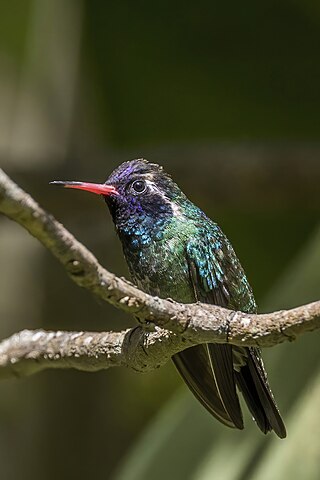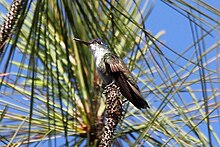
The copper-rumped hummingbird is a species of hummingbird in the "emeralds", tribe Trochilini of subfamily Trochilinae. It is found in Tobago, Trinidad, Venezuela, and possibly Grenada.

The steely-vented hummingbird is a species of hummingbird in the "emeralds", tribe Trochilini of subfamily Trochilinae. It is found in Colombia and Venezuela.

The blue-vented hummingbird is a species of hummingbird in the "emeralds", tribe Trochilini of subfamily Trochilinae. It is found in Costa Rica and Nicaragua.

The berylline hummingbird is a species of hummingbird in the "emeralds", tribe Trochilini of subfamily Trochilinae. It is found in El Salvador, Guatemala, Honduras, Mexico, and the United States.

The violet-crowned hummingbird is a hummingbird in the "emeralds", tribe Trochilini of subfamily Trochilinae. It is found in Mexico and the southwestern United States.

The white-eared hummingbird is a species of hummingbird in the "emeralds", tribe Trochilini of subfamily Trochilinae. It is found from the southwestern U.S. to Nicaragua.

The Andean emerald is a species of hummingbird in the "emeralds", tribe Trochilini of subfamily Trochilinae. It is found in Colombia, Ecuador, and Peru.

The white-bellied emerald is a species of hummingbird in the "emeralds", tribe Trochilini of subfamily Trochilinae. It is found in Belize, Guatemala, Honduras, Panamá, Mexico, and Nicaragua.

The indigo-capped hummingbird is a species of hummingbird in the "emeralds", tribe Trochilini of subfamily Trochilinae. It is endemic to Colombia.

The blue-tailed hummingbird is a species of hummingbird in the "emeralds", tribe Trochilini of subfamily Trochilinae. It is found in Costa Rica, El Salvador, Guatemala, Honduras, Mexico, and Nicaragua.

The snowy-bellied hummingbird, also known as snowy-breasted hummingbird, is a species of hummingbird in the "emeralds", tribe Trochilini of subfamily Trochilinae. It is found in mostly in Costa Rica and Panama with a few records in Colombia.

The green-fronted hummingbird is a species of hummingbird in the "emeralds", tribe Trochilini of subfamily Trochilinae. It is found in Mexico and possibly Guatemala.

The green-bellied hummingbird is a species of hummingbird in the "emeralds” tribe Trochilini of subfamily Trochilinae. It is found in Colombia and Venezuela.

The wedge-tailed sabrewing is a species of hummingbird in the "emeralds", tribe Trochilini of subfamily Trochilinae. It is found in Belize, Guatemala, Mexico, and possibly Honduras.

The golden-tailed sapphire is a species of hummingbird in the family Trochilidae. It is found in Bolivia, Brazil, Colombia, Ecuador, Peru, and Venezuela.

The Blue-headed sapphire or Gray's hummingbird is a species of hummingbird in the emerald's tribe Trochilini of subfamily Trochilidae. It is found in Colombia and Ecuador.

Humboldt's sapphire or Humboldt's hummingbird is a species of hummingbird in the "emeralds", tribe Trochilini of subfamily Trochilinae. It is found in Colombia, Ecuador, and Panama.

The curve-winged sabrewing is a species of hummingbird in the "emeralds", tribe Trochilini of subfamily Trochilinae. It is endemic to Mexico.

The copper-tailed hummingbird is a species of hummingbird in the "emeralds", tribe Trochilini of subfamily Trochilinae. It is native to the tepuis of Venezuela and nearby areas of Brazil and Guyana ; it is a vagrant in French Guiana.

The cinnamon-sided hummingbird is a species of hummingbird in the "emeralds", tribe Trochilini of subfamily Trochilinae. It is endemic to the Mexican state of Oaxaca.























